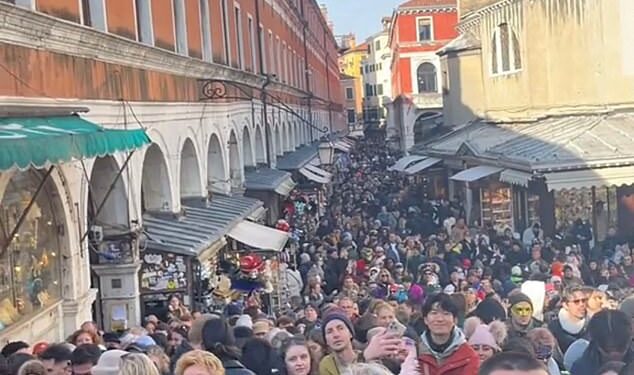The streets of Venice were plunged into chaos over the weekend after swarms of tourists stormed the Italian city as it kicked off its iconic Carnival.
Shocking footage shared on social media shows thousands of visitors congesting the narrow Venetian streets near the Grand Canal as they tried to make their way along the water to catch a glimpse of the parade.
Other clips show holidaymakers slowly trying to push past the crowds on the city’s famous Rialto bridge.
Social media users were quick to voice their opinions on the overcrowding caused by tourists.
‘But why do we have to live like this?’, one X user wrote. ‘Shouldn’t we stop all the events that attract crowds of tourists? The city is full anyway, is it necessary to make it unlivable at these levels?’.
Another wrote: ‘A good reason not to go to Venice. It has become a tourist trap.’
The invasion of holidaymakers comes despite a massive attempt from city officials to clamp down on tourist numbers.
In just a few weeks, visitors will have to pay a city entrance fee of five euros as part of an attempt to manage the flow of some 30 million tourists drawn by Venice’s historic and romantic canals each year.

Shocking footage shows how Venice was plunged into chaos as swarms of tourists descended on the Italian city for Carnival

It comes just a few weeks before Venice introduces a city entrance fee of five euros for day tourists

Other clips show holidaymakers slowly trying to push past the crowds on the city’s famous Rialto bridge
The controversial ‘tourist tax’ will come into force following a successful trial last year which saw city officials impose the day-tripper fee for 29 days.
Tourists will be charged every Friday to Sunday and on public holidays, between April 18 and July 27 this year.
The levy does not apply to people staying in hotels in Venice, who are already charged a lodging tax.
Exemptions also applied to children under 14, residents of the region, students, workers and people visiting relatives, among others.
The day trip fee could rise to 10 euros if tourists book less than four days in advance, however.
Last year, the city’s mayor Luigi Brugnaro said that the objective of the city entrance fee was to discourage tourists from visiting Venice on the same day to give it ‘the respect it deserves’.
Representatives argue the fee will not fix the fundamental issues but only cloud the city’s public image.
There are approximately 250,000 people living in the region although only approximately 60,000 live in the Renaissance city itself.
Locals have been grappling with over tourism and the impact it has had on their living conditions, and have taken to the streets in recent years to demonstrate against the number of visitors arriving to the Floating City.
In 2021, Venice banned large cruise ships from its historic center to protect its fragile environment.

Videos shared on social media showed thousands of visitors congesting the narrow Venetian streets near the Grand Canal
The city has also been added to UNESCO’s list if ‘world heritage in danger’ sites.
But Venice is not the first European city to crack down on over-tourism, with scores of protests erupting in Greece and Spain last summer.
In May last year, furious protesters took to the streets of the Greek capital to voice their outrage at the rising numbers of tourists flooding their home.
Huge signs sprayed onto the sides of buildings and other walls across the sun-soaked city present a chilling warning to visitors, with one reading: ‘Tourists Go Home! Greek State Kills’.
In Menorca, graffiti sprung up on walls telling tourists to ‘go home’, while in Marbella last year, tyres on cars with British number plates were slashed.
Most notably, around 250 protesters impeded tourist access to a picture-postcard Menorcan beach in a ‘surprise action’ in July last year.
Activists boasted of filling a car park by Cala Turqueta, a beautiful cove on the island’s southern coast, with ‘residents’ cars’.
They then used towels and their own bodies to shape the message ‘SOS Menorca’ on the sand by the waterline.
Last April, thousands of protestors took to the streets of the Canary Islands to protest against the problems caused by mass tourism and demand their politicians take action.
The protesters chanted the slogan: ‘Canarias tiene un limite’, which in English translates as ‘The Canary Islands have a limit.’
In another instance, protesters squirted tourists with water guns as they dined along a waterfront district in Barcelona.





